Breamore
| Breamore | |
| Hampshire | |
|---|---|
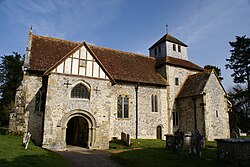 St Mary's Church, Breamore | |
| Location | |
| Grid reference: | SU158180 |
| Location: | 50°57’43"N, 1°46’30"W |
| Data | |
| Population: | 363 (2001) |
| Post town: | Fordingbridge |
| Postcode: | SP6 |
| Dialling code: | 01725 |
| Local Government | |
| Council: | New Forest |
| Parliamentary constituency: |
New Forest West |
| Website: | Breamore Parish Council |
Breamore is a village in Hampshire, in the valley of the River Avon near Fordingbridge. The village's name is pronounced "Bremmer".
The village and its parish have two remarkable buildings: Beamore House, a grand Elizabethan country house, and the parish church, Saint Mary, which is one of the best examples of a surviving Anglo-Saxon church, with a rood of that period and a bold Old English evangelical inscription.
The village
The village of Breamore is mainly situated along the A338 between Fordingbridge and Downton, although the Saxon church and Breamore House are about three-quarters of a mile west of the road.[1] Within the Parish is the Marsh (an important surviving manorial green)[2] and the River Avon: both are listed as "Sites of Special Scientific Interest".[3] Other parts of the Parish fall within the Cranbourne Chase and West Wiltshire Downs, and are an "Area of Outstanding Natural Beauty".[3]
History

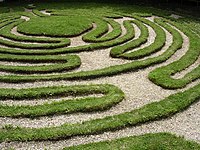
Breamore Down has several Bronze Age bowl barrows.[1] There is also a long barrow known as the Giant's Grave, originally 65m long and 26m wide with flanked ditches, it is now partly damaged.[2] Breamore Down also has a mysterious mizmaze on its heights.[1] Argument rages as to whether the Bronze Age people or mediæval monks were responsible for these patterns cut in the turf.[1]
The name Breamore, recorded as Brumore in 1086, may be derived from Old English "Brommor" meaning "broom(covered) marsh".[4] At an early date the manor of Breamore belonged to the Crown, and in 1086 was part of the royal manor of Rockbourne.
At an early date, probably by grant of Henry I, Breamore passed to the Earls of Devon, lords of the Isle of Wight, who held it from the king in chief.[5] In 1299 Edward I assigned the manor to his queen, Margaret of France, but in 1302 Breamore was delivered to Hugh de Courtenay.[5] From that time it descended with the Earls of Devon until it was granted, in 1467, to Walter Blount, 1st Baron Mountjoy.[5] In 1475 Breamore escheated to the king, who granted it for life in 1490 to Sir Hugh Conway and Elizabeth his wife.[5] In 1512 it was granted in 1512 to Catherine of York widow of William Courtenay, 1st Earl of Devon and her heirs.[5] Her son Henry was created Marquess of Exeter in 1525, but was beheaded in 1538–9, and the manor again passed to the Crown.[5]
In 1541, King Henry VIII gave the manor to his queen, Catherine Howard, and in 1544 to Catherine Parr, who, after the King's death married Thomas Seymour, 1st Baron Seymour of Sudeley, to whom Breamore was granted by Edward VI in 1547.[5] On his execution in 1549 it again passed to the Crown and was granted in 1579 by Elizabeth I to her favourite, Christopher Hatton.[5] William Dodington bought it from Hatton.[5] From this date Breamore followed the descent of South Charford until 1741, when Francis Lord Brooke sold it to Samuel Dixon, preliminary to its sale to Sir Edward Hulse.[5]
Breamore railway station was opened in 1866.[6] It was served by the Salisbury and Dorset Junction Railway, a line running North-South along the River Avon, connecting Salisbury to the North and Poole to the South.[6] It closed in 1964.[6] The disused station still exists on the road that leads east from the A338.
St Mary's church
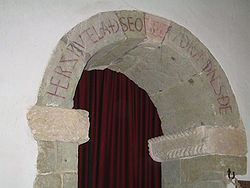
The church of Saint Mary stands outside the village, in what is presumably the village's original location. It is however close by Breamore House. St Mary's is an almost complete example of an Anglo-Saxon church,[7] and one of the finest examples in the land. The building consists of a chancel and aisleless nave, separated by square central tower.[7]
The east window with net like tracery dates from 1340.[7] There is a "leper window" in the north wall.[7] Seven "double-splayed" Saxon windows remain.[7]
The chancel arch and arch in west wall of the tower are 15th century.[7] The tower houses four bells cast in late 16th and early 17th centuries.[7]
There is a bold text in the English language carved into an arch; arch interrupted by later work so that we do not know whether the words we see today are the complete original text; this is believed to date from the reign of King Ethelred II ("the Unready"):
HER SWUTELAÐ SEO GECWYDRÆDNES ÐE
There also remains a much mutilated Saxon rood with figures of Mary and Saint John.[7]
Breamore House
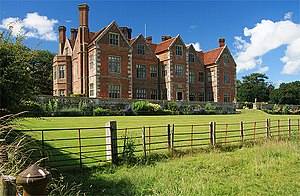
Breamore House stands north-west of the church.[5] The original house was a very fine late 16th-century building of brick and stone, but was unfortunately burnt in 1856.[5] It was restored on the old lines, incorporating such of the old masonry as was left, and now from a short distance still resembles an Elizabethan building.[5]
The house is built with an E-shaped ground plan.[8]
Breamore Priory
The priory of Breamore was founded towards the end of the reign of Henry I by Baldwin de Redvers and Hugh his uncle, to whose descendants the advowson belonged.[5] It was apparently visited by Richard II in 1384.[5] Baldwin and Hugh de Redvers endowed their priory of Breamore with certain land in Breamore which formed the nucleus of the manor later known as Breamore Bulborn.[5] Various donors added gifts of adjoining land which were merged in the manor.[5]
On the dissolution of the priory in July 1536 the site was granted in November of that year with the manors of Breamore and Bulborn to Henry Courtenay, 1st Marquess of Exeter and his wife Gertrude.[5] It then followed the descent of Breamore Bulborn, becoming merged in that manor.[5]
Village stocks
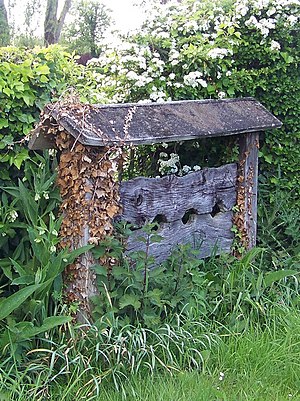
The village stocks can be seen by the A338 roadside.[9] They were originally at the road junction, but are now opposite the Bat and Ball Hotel.[10]
The stocks have a whipping post and horizontals with four leg holes.[10] A modern roof has been erected over them.[9] They were restored after being badly damaged by a lorry,[10] but they have not been brought back into use.
Outside links
| ("Wikimedia Commons" has material about Breamore) |
References
- ↑ 1.0 1.1 1.2 1.3 Hampshire Treasures Volume 5 (New Forest) Page 33, retrieved 12 October 2011
- ↑ 2.0 2.1 Hampshire Treasures Volume 5 (New Forest) Page 35, retrieved 12 October 2011
- ↑ 3.0 3.1 Breamore Parish Council
- ↑ Breamore, Old Hampshire Gazetteer
- ↑ 5.00 5.01 5.02 5.03 5.04 5.05 5.06 5.07 5.08 5.09 5.10 5.11 5.12 5.13 5.14 5.15 5.16 5.17 5.18 Victoria County History of Hampshire: Breamore
- ↑ 6.0 6.1 6.2 Breamore, Disused Stations, retrieved 12 October 2011
- ↑ 7.0 7.1 7.2 7.3 7.4 7.5 7.6 7.7 Hampshire Treasures Volume 5 (New Forest) Page 37, retrieved 12 October 2011
- ↑ "History of the House". http://www.breamorehouse.com/page819.html. Retrieved 2010-05-31.
- ↑ 9.0 9.1 Hampshire Treasures Volume 5 (New Forest) Page 40, retrieved 12 October 2011
- ↑ 10.0 10.1 10.2 Breamore Stocks, Old Hampshire Gazetteer
